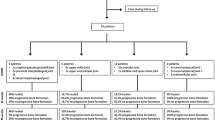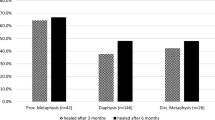Summary
Extracorporal shock wave therapy (ESWT) has been postulated as an additional therapeutic option in nonunion after fracture treatment. We have reexamined patients with nonunions treated at our institution to evaluate the efficacy of the method. In a prospective nonrandomized study patients were investigated with a minimum duration of nonunion of 6 months. Following 2 cycles of ESWT with 2000 impulses/18 kV, the reevaluation was performed at 1, 3 and 6 months after treatment. A total of 27 pseudarthroses was reevaluated, in 11 one or more reosteosyntheses had been performed prior to ESWT. Following ESWT we found a success rate of 41 % (n = 11). The clinical evidence of subjective, clinical improvement was found in 5 of these patients within 1 month, in all of these patients within a period of 3 months. Radiologic evidence of improvement occurred in none of these patients within 1 month, in all of these patients within 6 months. ESWT appears to represent an additional treatment option in patients with longstanding nonunion. If no improvement occurs, the maximum delay of reosteosynthesis is three months.
Zusammenfassung
Die extrakorporale Stoßwellentherapie (ESWT) wurde in den letzten Jahren als nicht-invasive, risikoarme Behandlungsmöglichkeit in der Therapie von Pseudarthrosen (PA) propagiert. Das Ziel dieser prospektiven klinischen Untersuchung war es, anhand des eigenen Patientenguts die Auswirkungen der ESWT auf den Heilungsverlauf von Pseudarthrosen des Röhrenknochens zu überprüfen. Patienten mit einer Pseudarthrosendauer > 6 Monaten wurden in 2 Sitzungen mit jeweils 2000 Impulsen und 18 kV ESWT behandelt. Eine Nachuntersuchung erfolgte 1, 3 und 6 Monate nach der 2. ESWT; 25 Patienten mit 27 Pseudarthrosen haben den Nachuntersuchungszeitraum von 6 Monaten erreicht. In 11 von 27 PA kam es klinisch und radiologisch zur Ausheilung (41 %). Eine klinische Besserungstendenz trat bei 5 Patienten bereits innerhalb des 1. Monats auf, bei allen Patienten innerhalb der ersten 3 Monate. Eine radiologische Durchbauung zeigte sich in keinem Fall innerhalb des 1. Monats, bei allen jedoch innerhalb der ersten 3 Monate. Somit verzögert sich bei Mißerfolg der ESWT eine Reosteosynthese maximal um 3 Monate. Der Einsatz der ESWT erscheint daher bei einer Pseudarthrosendauer > 6 Monate von Röhrenknochen als adjuvante, nicht-invasive Behandlung gerechtfertigt.
Similar content being viewed by others
Author information
Authors and Affiliations
Rights and permissions
About this article
Cite this article
Beutler, S., Regel, G., Pape, H. et al. Extracorporeal shock wave therapy for delayed union of long bone fractures – preliminary results of a prospective cohort study. Unfallchirurg 102, 839–847 (1999). https://doi.org/10.1007/s001130050492
Published:
Issue Date:
DOI: https://doi.org/10.1007/s001130050492




